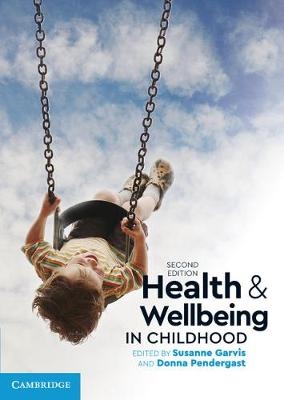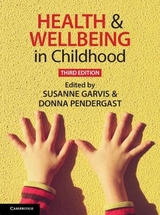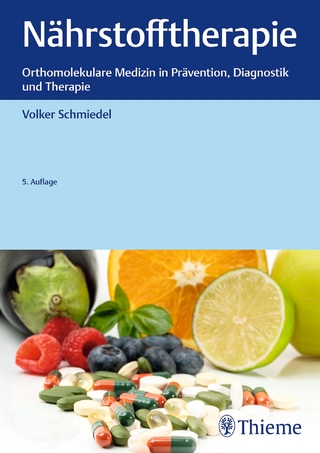
Health and Wellbeing in Childhood
Cambridge University Press (Verlag)
978-1-316-62300-8 (ISBN)
- Titel erscheint in neuer Auflage
- Artikel merken
The period from birth to twelve years is crucial in a child's development and can significantly impact future educational success, resilience and participation in society. Health and Wellbeing in Childhood, 2nd edition provides readers with a comprehensive foundation in health and wellbeing education across key priority areas, covering physical, social and emotional learning and development. This edition has been thoroughly updated to include the latest research and resources and incorporates expanded material on diversity, mental health and contemplative practice. Learning is supported through a suite of features including key terms, case studies, links to curriculum documentation, reflective activities and end-of-chapter questions. A new instructor companion website features a curated suite of reading materials, extension questions and sample responses. Written by an expert author team comprised of leading academics and practitioners, Health and Wellbeing in Childhood equips readers with the knowledge and skills to promote and implement effective practice in the field.
Susanne Garvis is a professor of child and youth studies (early childhood) at Göteborgs Universitet, Sweden. Donna Pendergast is a Professor and Dean of the School of Education and Professional Studies at Griffith University, Queensland.
Part I. Context: 1. The importance of health and wellbeing Donna Pendergast and Susanne Garvis; 2. Classifying health and wellbeing: applying the International Classification of Functioning, Disability and Health to early years learners Jane McCormack and Sharynne McLeod; Part II. Dimensions of Health and Wellbeing: 3. Addressing developmental challenges to improve the wellbeing of children Matthew Manning; 4. Communication development Jane McCormack, Sharynne McLeod and Linda J. Harrison; 5. Physically educated: developing children's health and well-being through movement and motor skills Timothy J. Lynch; 6. Sexual abuse prevention education Kerryann Walsh, Donna Berthelsen and Jan M. Nicholson; 7. Child safety Susanne Garvis and Donna Pendergast; 8. Social determinants of health and wellbeing Margaret Sims; 9. Friendships Maryanne Theobald, Susan Danby, Catherine Thompson and Karen Thorpe; 10. Food for thought: the role of teachers and parents in children's food choices Natalie Parletta; 11. Body image of pre-adolescents Galina Daraganova; Part III. Applications: 12. Teaching for social and emotional learning Wendi Beamish and Fiona Bryer; 13. Talking circles Jennifer Cartmel, Marilyn Casley and Kerry Smith; 14. Partnering with families Sivanes Phillipson; 15. Being a digital image-maker: young children using the digital camera in learning Narelle Lemon; 16. Promoting wellbeing with educationally disadvantaged children through community partnerships Susan L. Whatman; 17. Supporting resilience Andrea Nolan, Karen Stagnitti, Ann Taket and Siobhan Casey; 18. Move Well Eat Well: a case study of a successful settings-based approach to health promotion Janet Dyment, Sherridan Emery, Theresa Doherty and Mary Eckhardt; 19. Fostering children's wellbeing through play opportunities Marjory Ebbeck, Hoi Yin Bonnie Yim and Lai Wan Maria Lee; 20. Bullying and social emotional wellbeing in children Cathrine Neilsen-Hewett and Kay Bussey; 21. Strengthening social and emotional learning in children with special needs Wendi Beamish and Beth Saggers; Part IV. Leadership and Innovations: 22. Teachers' roles in building girls' leadership identity Nicole Archard, Romana Morda and Manjula Waniganayake; 23. Building the capacity of early childhood educators to promote children's mental health: learnings from three new programs Sarah Cavanagh, Jo Cole, Judy Kynaston, Kim-Michelle Gilson, Elise Davis and Gavin Hazel; 24. Loose parts on the school playground: a playful approach to promoting health and wellbeing for children of all abilities Shirley Wyver, Anita Bundy, Lina Engelen, Geraldine Naughton and Anita Nelson Niehues; 25. Using contemplative practices to enhance teaching, leadership and wellbeing Alison L. Black, Gillian Busch and Christine Woodrow.
| Erscheinungsdatum | 23.11.2017 |
|---|---|
| Zusatzinfo | 21 Tables, black and white; 37 Halftones, black and white; 33 Line drawings, black and white |
| Verlagsort | Cambridge |
| Sprache | englisch |
| Maße | 177 x 250 mm |
| Gewicht | 840 g |
| Themenwelt | Studium ► Querschnittsbereiche ► Prävention / Gesundheitsförderung |
| Sozialwissenschaften ► Pädagogik ► Allgemeines / Lexika | |
| ISBN-10 | 1-316-62300-9 / 1316623009 |
| ISBN-13 | 978-1-316-62300-8 / 9781316623008 |
| Zustand | Neuware |
| Haben Sie eine Frage zum Produkt? |
aus dem Bereich



